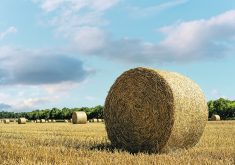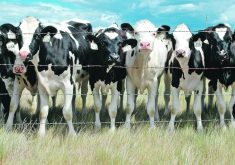Glacier FarmMedia – New research on transition cows shows that dairy farmers should adjust some traditional ways of handling post-calving calcium levels and ketosis.
More than half of dairy cows in highly managed herds go through the transition period to milking with at least one health problem. Recent research shows those problems reduce the cow’s chance of success throughout the rest of its lactation.
Dr. Stephen LeBlanc of the University of Guelph says those numbers aren’t surprising. About 50 per cent of NHL hockey players will have an injury from which they’ll miss at least one game.
Read Also

Trump’s tariffs take their toll on U.S. producers
U.S. farmers say Trump’s tariffs have been devastating for growers in that country.
Similarly, dairy cows are considered athletes for the precision with which they produce large volumes of milk.
LeBlanc says numerous studies have shown the effect of transition period illnesses on reproduction.
A Florida study with a dataset of 4,000 cows showed that if a cow was sick during transition and got pregnant, that wasn’t the end of the worry for the farmer.
“Even the cows who got pregnant, if they had lived through one disease, or even worse, two diseases two, three, four, five months in the past, they were much more likely to lose that pregnancy subsequently,” said LeBlanc at the Progressive Dairy Operators triennial symposium in Toronto.
Managing transition illness is key. LeBlanc says there’s new thinking on use of calcium to avoid milk fever, and he recommends monitoring cows for ketosis and body condition score to understand the metabolic challenges faced by cows.
“We need to think a little bit differently about hypercalcemia,” says LeBlanc.
Better transition cow nutrition has resulted in fewer cases of clinical hypocalcemia, also known as milk fever. As a result, researchers have paid more attention to calcium management in cows post-calving.
They have found that a drop in blood calcium the day after calving is normal, as long as the cow’s blood calcium quickly recovers on the second day.
“Now we’re measuring cows at day four after calving, not on day one.”
Cows in a New York study at Cornell University led much of this new thinking. When the animals didn’t recover their calcium by day four post-calving, they had worse outcomes.
“Cows that were discalcemic didn’t recover well and had the worst reproductive performance two or three months into the future,” LeBlanc says.
The cows didn’t have low calcium at breeding or when they were preg checked, but low calcium shortly after calving affected their future reproductive ability.
Researchers are trying to figure out how to manage cows with blood calcium that doesn’t recover after day four.
In addition to new thinking on when to measure blood calcium, researchers question whether the current practice of giving cows calcium treatments, usually through a bolus after calving, has much effect.
“These can have a niche. There’s a place for them,” says LeBlanc. “But we need to be honest with ourselves. That’s not going to just fix the problem because we gave a drench or a bolus.”
Ketosis is a metabolic disease of ruminants. When cows produce excess amounts of ketones in their blood, it has numerous impacts, including greater risk of metritis and subclinical endometritis, which is uterine inflammation that results in 50 per cent less chance the cow will cycle.
This happens around the transition period, but LeBlanc says the chances that a cow is still ketotic when she’s bred are small, so like low calcium around calving, ketosis at that point also has long-term effects, especially on reproduction.
Like low calcium treatment, there are changing thoughts on how to treat ketosis. At one point dexamethasone was used, but that’s no longer recommended.
Research has shown that once-per-day milking can eliminate ketosis, but that will also reduce the cow’s yearly production.
Research has also shown that drenching ketotic cows with a propylene glycol drench can help, but 25 per cent still have elevated ketone levels after treatment.
LeBlanc recommends getting a handle on transition cow challenges in a herd.
- Measure the betahydroxybutyrate (BHB) levels of fresh cows. BHB is an indicator of high ketone levels. Sample the next 30 cows that calve three times between three and 12 days in milk, either with milk or blood tests. If more than 15 per cent have higher ketone levels, investigate.
- Monitor cows for puss discharge once between 15 and 42 days in milk. If more than 15 per cent are identified, that’s a concern. If the frequency is greater than five per cent and first insemination pregnancies are less than 40 per cent, test and treat.
- Check body condition score at calving and at four weeks post calving.
- Review metritis detection and treatment. Cows with a fetid discharge at less than eight days in milk will likely benefit from treatment.
















